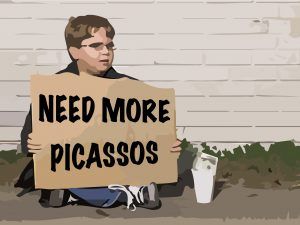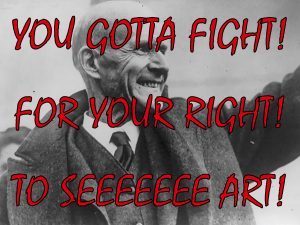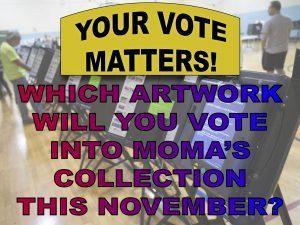by Nickolas Calabrese

Is art “a right or a privilege”? This question was addressed by a who’s who of artworld elites in a New York Times feature earlier this year with regards to the Metropolitan Museum of Art’s revised policy to charge out-of-towners the full $25.00 admission fee rather than their standard pay-what-you-wish policy. Predictably, this group (many of them known for their overt political or moral activism, like Ai Weiwei) overwhelmingly endorsed its status as a right (there was one dissenter, but even that came with caveats). Perhaps one of the most prominent defenders of this view, because of her station and her institutional influence, is Aggie Gund, President Emerita of the Museum of Modern Art in New York. She frequently states that “art is a right, not a privilege” (as she discusses in the beginning of this interview).
As framed here, it is unclear precisely what their statement is declaring. I understand it to mean one of two things: (1) Access to art is a moral right; that is, the belief that our ability to freely appreciate and produce art objects is, generally speaking, good and ought to be defended. This looks prima facie true to me. One would be hard-pressed to deny the moral good of the freedom to produce and appreciate art, barring extreme cases like hateful art, or propaganda attributed to and distributed by despotic regimes, such as the arts that Hitler or Mussolini championed in their lifetimes. This account would also be protective of art as a facet of free speech, which also seems like a mostly good thing. There is a more rigid account of art as a right, one which makes a more serious claim: (2) Access to art ought to be a legal right; that free access to museums and other institutions housing cultural artifacts should be legally guaranteed to citizens. I believe that this second usage is what is being suggested by Gund and the respondents in the NYT article, because the first claim is nearly unanimous, and anyone who would disagree with it is probably some kind of monster. But it is this second account that I am going to dispute.
To be clear, I love art. I live and breath it. It is my profession and my passion. The pleasure I receive from making and experiencing art is of course a fundamental “right”, just as much as it is my right to dislike the current president, or to cook an excellent pork shoulder in my slow cooker. These rights are essentially unchallengeable, at least in the US, at least for now. It seems obvious that the enjoyment of beautiful objects by a private citizen is ok, although I actually wouldn’t even go so far as to call this a case of “rights”. That would be like declaring that thoughts about how food tastes are a right. Aesthetic exercises like enjoyment and looking are facets of human cognition, not rights. By attempting to reduce it to an issue of legal entitlement, we are making a category mistake of what aesthetic enjoyment consists of. If one wants to make a legal insistence on access to art being a matter of legal right, one would need to be more specific about the letter and the spirit.
 The question restated might be: should access to art institutions be mandated as a legal right for all citizens? The institution is explicitly included here because that is what’s being referred to by Gund, et al, and it’s the most public locus for art experiences in most societies. The common sense response to the question of why art ought to be a right in the NYT article amounts to ‘because we want it to be’. A fairer assessment might be that art ought to be a right because it provides insight into our cultural pillars, culture being the glue that binds people together. I agree with this as a matter of course. But a series of tough questions are raised as a consequence. First, and importantly, who decides what qualifies as art? When Gund says “art”, she cannot mean all of the art in the world. She isn’t referring to the art being produced by countless undergrads at sub-par universities. She isn’t referring to those outsiders who are not producing art for exhibition. What about qualitatively bad art? Is hateful art a right? Fascist art? Should art fairs be free? What about the Met Opera? Surely Wagner’s Ring cycle qualifies as art, and should be free. What about HBO? Programs like The Wire and the first season of True Detective must count high enough to meet the sufficient conditions as an artwork. What about Disney on Ice? The incorporation of dance, song, acting, and athleticism into a childhood fantasy Gesamtkunstwerk must fulfill the qualifications of an artwork.
The question restated might be: should access to art institutions be mandated as a legal right for all citizens? The institution is explicitly included here because that is what’s being referred to by Gund, et al, and it’s the most public locus for art experiences in most societies. The common sense response to the question of why art ought to be a right in the NYT article amounts to ‘because we want it to be’. A fairer assessment might be that art ought to be a right because it provides insight into our cultural pillars, culture being the glue that binds people together. I agree with this as a matter of course. But a series of tough questions are raised as a consequence. First, and importantly, who decides what qualifies as art? When Gund says “art”, she cannot mean all of the art in the world. She isn’t referring to the art being produced by countless undergrads at sub-par universities. She isn’t referring to those outsiders who are not producing art for exhibition. What about qualitatively bad art? Is hateful art a right? Fascist art? Should art fairs be free? What about the Met Opera? Surely Wagner’s Ring cycle qualifies as art, and should be free. What about HBO? Programs like The Wire and the first season of True Detective must count high enough to meet the sufficient conditions as an artwork. What about Disney on Ice? The incorporation of dance, song, acting, and athleticism into a childhood fantasy Gesamtkunstwerk must fulfill the qualifications of an artwork.
These considerations are purely rhetorical because we already know who chooses what counts as art. Art is the stuff bought by a private group of aggressively wealthy people who can afford it. The objects that populate art institutions of the world are put there with zero input from a general public. Given that this is the case, then the initial question could be framed thusly: artwork that has been purchased by public art collections or by private collectors and then donated to public collections should be accessible for free, perhaps with some legal mandate that it remain free (or admission is purchasable on a sliding scale basis) as long as those museums accept federal, state, or city funding (I would also include non-collecting institutions like PS1 and the New Museum because they also receive at least some funding from these sources). In this case, the concept of free access to art would necessarily be reduced to art that is part of “the cannon”. Art is a right if it has been approved by an elite community of museum acquisition board members, collectors, art advisors, and investors. It should be noted that the acquisition boards at museums are very often shepherded by private collectors who have a real financial stake in what those same museums collect or exhibit (for instance Dakis Joannou is on the board of trustees at the New Museum, which mounted a show of his private collection in 2010 titled Skin Fruit, and has shown several solo exhibitions of the artists who he champions, further galvanizing the legitimacy and value of his collection – in other parts of the greater economy this would be called insider trading or worse).
Art is a private endeavor in many ways. It is made by a person who possesses a skill, and that skill is to make art. There is no magic in the production of objects. It is just a highly rewarded (in a very small number of cases) instance of labor. And that labor is rewarded by elites who purchase those fruits. To fail to acknowledge the relationship between the art market economy and artistic production and collection would be a great disservice to museum-goers. The art market is dangerously inbred with tactics of neoliberal capitalism. As Mikkel Bolt Rasmussen neatly sums it up in his thoughtful new book After the Great Refusal (2018): “The speculation economy of neo-liberal capitalism pumped huge sums of money into the art market after 1989, with the result that art today is closely tied to the transnational circulation of capital. At the same time, national governments, provinces and cities use art as a marketing instrument in the febrile competition for investments and tourists. These developments towards an ever-closer link between art and capital, and between art and the ruling order, are undoubtedly the predominant tendency when it comes to contemporary art.”
Artists who are not included in public or private art collections are evidently left out of the conversation being had by the NYT interlocutors. Imagine the average artist’s umbrage at the question of whether art is a right when they are certainly not part of that discussion. Or is the art in their own home, because nobody has collected it, a public right as well? Limiting our definition to that of the institution limits the conversation to, really, just a tiny handful of successful artists and artworks in the world. This sort of exclusion is just the sort of thing that art as a right attempts to reverse. It would be woefully naive to ignore how this elite group of art collectors have at least some play in manipulating the great collections of art in the world when it frequently serves to display, or worse, to conceal their wealth (like Ronald Lauder using his non-profit art foundation as a filter for tax huge benefits).
 A practical, slightly utopian solution to the problem is to let the general public vote on which artists and artworks enter public collections like the Met. Now, this is not something that I, for one, seriously desire. Much of the art that I prefer is historically maligned for being “transgressive” or “outsider” or some other public affront and as such would likely not be voted for by the general population. But for the sake of the topic, and in an effort to save face for its legitimacy, art would seem like more of a legal right if the people had some sort of say in what the collection looked like. It would be compelling as a concept if we could vote on it as we do with other civic rights. Or at the very least we could vote on which curators and board members are elected to service at museums. It would provide an obstacle to the power that millionaire and billionaire collectors wield as a consequence of their holdings, while providing the public an efficacious handling of the collection that reflects collective taste. Perhaps the Koch brothers wouldn’t have been chosen to fund the hideous fountains at the Met if the public had a say in the matter.
A practical, slightly utopian solution to the problem is to let the general public vote on which artists and artworks enter public collections like the Met. Now, this is not something that I, for one, seriously desire. Much of the art that I prefer is historically maligned for being “transgressive” or “outsider” or some other public affront and as such would likely not be voted for by the general population. But for the sake of the topic, and in an effort to save face for its legitimacy, art would seem like more of a legal right if the people had some sort of say in what the collection looked like. It would be compelling as a concept if we could vote on it as we do with other civic rights. Or at the very least we could vote on which curators and board members are elected to service at museums. It would provide an obstacle to the power that millionaire and billionaire collectors wield as a consequence of their holdings, while providing the public an efficacious handling of the collection that reflects collective taste. Perhaps the Koch brothers wouldn’t have been chosen to fund the hideous fountains at the Met if the public had a say in the matter.
However, museums giving the public a chance to vote on their assets seems unlikely. So if art isn’t a right, then what is it? I think that this kind of thing is the very definition of a luxury item (a Veblen good, it’s a status symbol, and so it’s worth increases as it’s desire increases). The artworks in museums are a luxury. So is the opera. So is a meal at Per Se. None of these things hinge on our ability to live full lives. Does that make these things bad? No of course not. The arts are characterized by their tremendous effect on the culture of humanity, and as such they hold a precious place in society. But they don’t need to belong in museums for us to experience them. Growing up, there was a painting hanging in my house that was made by my father’s friend, which was completed while serving a lengthy prison sentence as an accessory to murder. This painting, which replicated a Frank Frazetta scene of a warrior riding a horse to fight some hell beasts, fills me with as much artistic gratification as any work hanging at the Met, and it is monetarily worth virtually nothing. This is because art is, at its best, a deeply personal experience. If the work doesn’t move you (given the proper level of education about the work in question), then fuck it – it’s not for you. The point is simply that we all know that art doesn’t require a price tag of $150,000 in order to profoundly impact us.
All of this is a simplified story about access to the arts, but it’s realistic. Artworks in museums are luxury items. Museums cater to an upper class in general. They have Michelin starred restaurants, were built by international rock-star architects, and hold galas for celebrities and the highest tier of society. They also provide regular people with an unforgettable experience, a wonderful one-on-one interaction with some of the most storied visual arts in history. They are spectacular places filled with marvels of human achievement. At the end of the day, of course we should advocate for free museums. Museums should be free because of the repugnant amounts of money spent to populate them (schade!) and because they can afford it. And they should be free because of benevolence on the part of those who own them – those who have it all should share it with those who have none as an act of goodwill. Charging a fee (that you don’t really need) to let people look at what you own is pretty fucked up.
